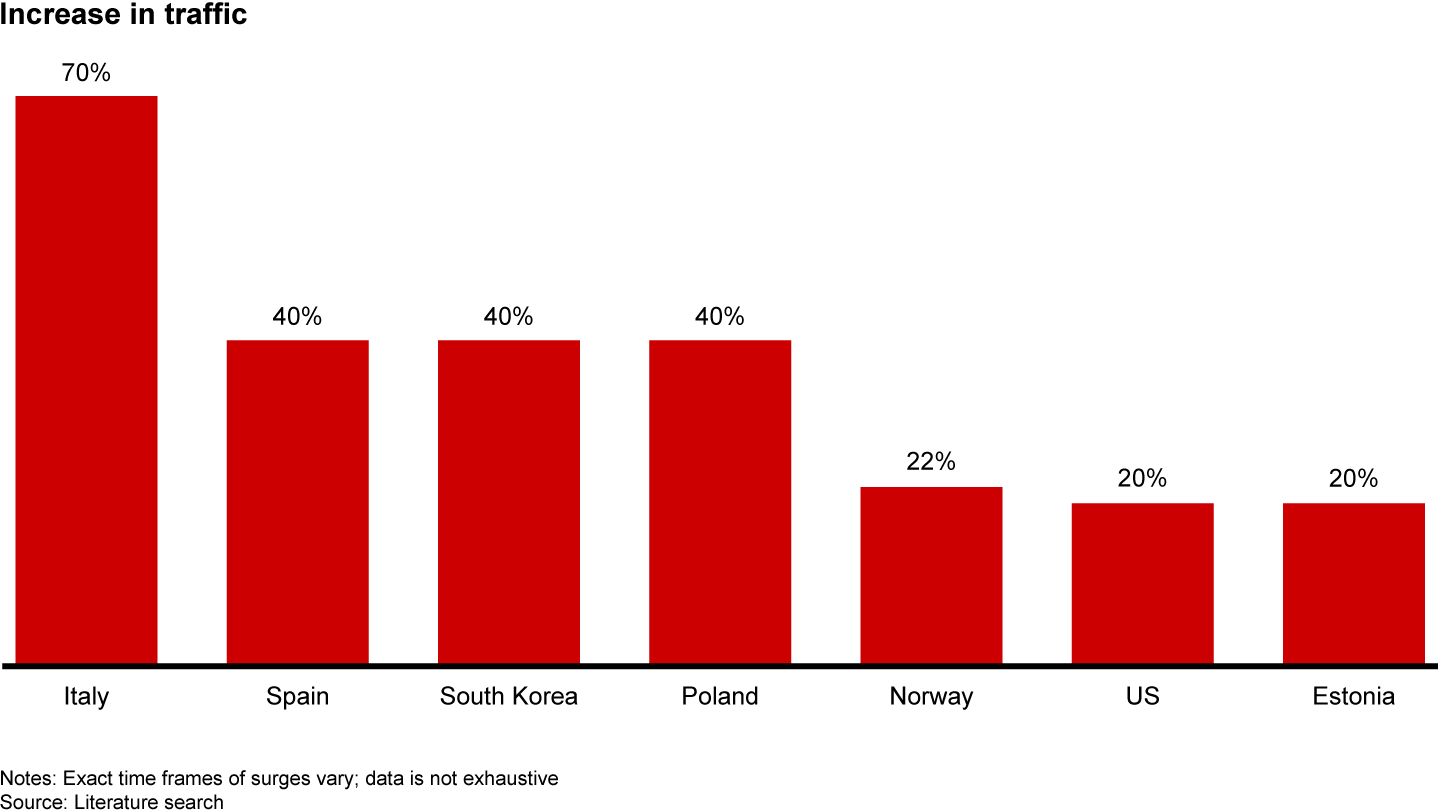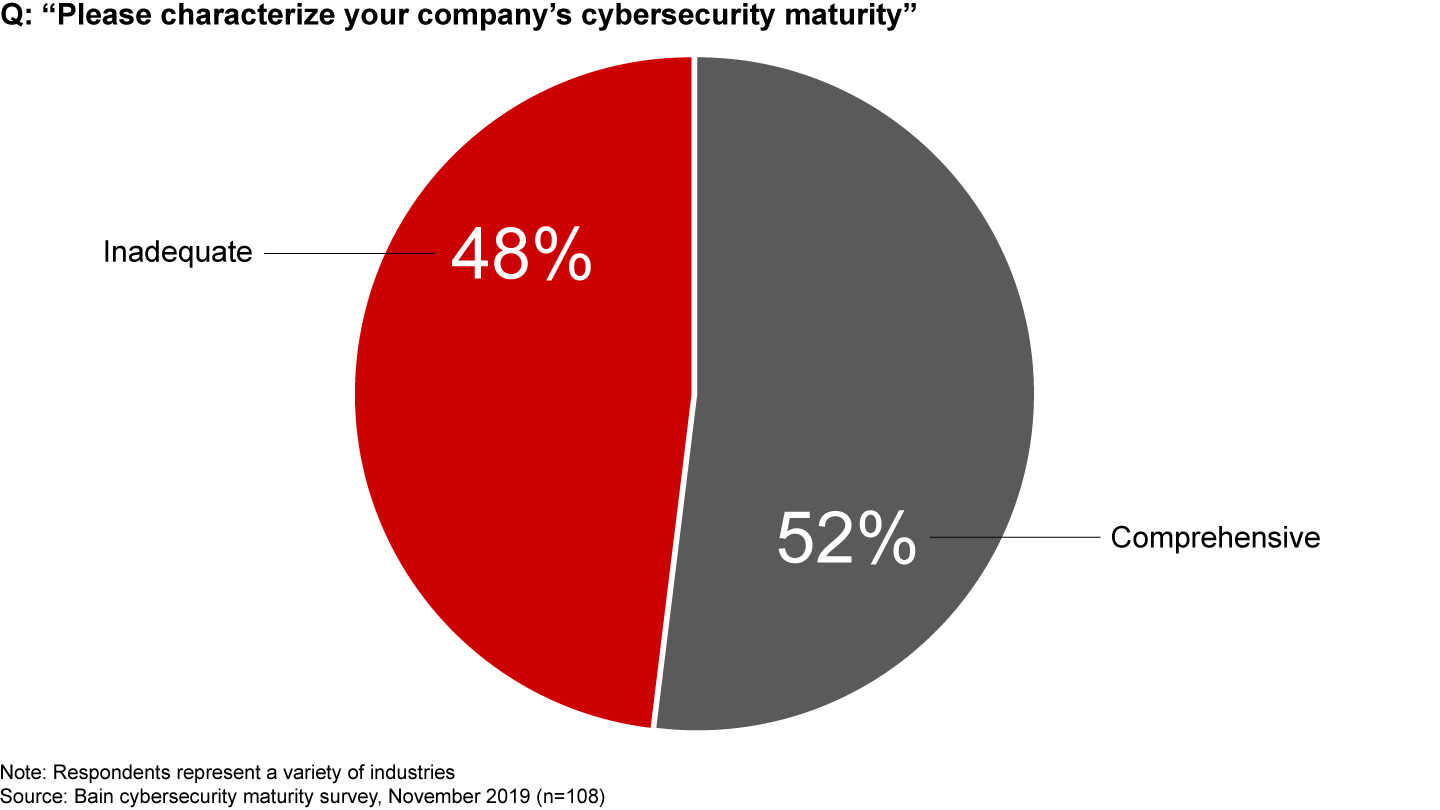Brief

Executive Summary
- Telcos are under enormous pressure to continue delivering critical infrastructure and services during the coronavirus outbreak.
- They can prioritize three short-term actions to manage the crisis: help people adjust to remote working and social distancing; stabilize operations; and invest in cybersecurity.
- Telcos that act quickly and effectively can help communities respond to the pandemic and emerge stronger.
With the world turned upside down by the coronavirus, telecommunications companies face one of the greatest challenges in their history. Like other organizations, they have a duty to, first and foremost, support and care for their employees. But telcos are also under enormous pressure to continue delivering infrastructure and services critical to everyone, especially during a crisis of this magnitude.
Telecom executives are scrambling to tackle a host of issues simultaneously. Given the urgency, we recommend prioritizing three short-term actions to manage the crisis before turning attention to the plan for recovery. Those that do so will not only help their communities and the world respond to the pandemic, but will emerge stronger in the aftermath.

Macro Surveillance Platform
For more detail on the business implications of coronavirus from Bain’s Macro Trends Group, log on to the Macro Surveillance Platform. Learn more about the platform >
1. Help people adjust for the long haul
With offices, schools and public places shuttering to contain the spread of the virus, there’s a shift en masse to remote working and to video and teleconferencing. Network traffic in some countries has surged 70% or more during the outbreak (see Figure 1).


Telcos can ease this transition by taking several immediate steps.
First, they can offer discounted or free voice, data and content services to customers. The menu could include enabling enterprise customers’ employees to call each other for free, allowing data overages and providing open access to applications and services, such as educational content and online learning platforms for students, teachers and parents.
Next, telcos should be ready to help customers upgrade their services to cope with higher bandwidth requirements as workers and their families spend more time at home. The options might include Internet speed-booster packages and switching connections from copper to higher-performing fiber-optic broadband services.
Telcos can offer comprehensive “workplace-as-a-service” solutions for customers, including remote working and conferencing hardware, unified communication packages and partnerships, and virtual private network (VPN) capabilities. They can also provide advice on how to set up and troubleshoot home office products, and even productivity checks with remote experts.
Lastly, telcos can respond to the needs of enterprise customers through payment flexibility or creating ad hoc support teams to assist critical organizations such as pharmacies, hospitals and other first responders.
Many telcos have begun enacting these solutions already. Those that act quickly and effectively can help people adjust to the difficult situation. By doing so, they can also build greater trust and loyalty among the communities they serve and reaffirm their core value proposition.
2. Stabilize operations in the new normal
The pandemic will likely push telcos to modify front- and back-office operations to be more flexible and resilient.
For example, the crisis will probably accelerate adoption of telcos’ digital customer-service channels and services. Companies can make this easier by directing customers to self-service channels through quick, coordinated changes to their automated voice-response programs, call-center scripts and in-store signs. One effective tactic could be forming Agile remote teams to design these measures to meet the needs of different customer groups, starting with seniors and professionals working from home.
Telcos’ brick-and-mortar stores and third-party dealer networks will see much lower foot traffic for the foreseeable future. But the upside is until things return to normal, store employees could support help desks, technicians and home deliveries. We suggest testing a few critical omnichannel customer-care approaches on a small scale to ensure consistency before rolling them out more widely.
On the other hand, call centers will field more customer inquiries during the outbreak, and telcos might consider planning new outbound contact programs. Customer churn is likely to drop dramatically during this period, so rebalancing the marketing team’s priorities to support product and service upgrades, setup and feedback could prove useful. Leading telcos will deploy feedback management tools to better understand and anticipate customer needs and take proactive measures.
Field engineers will remain on the physical front lines during the crisis, so special precautions will be required to protect their health. Visits to customers’ homes and offices will be reduced to only the most critical situations. With many isolated or quarantined premises, engineers will drop off equipment, then use remote video chats to help customers install or repair it. Additional precautions include limiting or staggering depot exchanges by taking vans home at night, fully stocked. Up-to-date inventory will be vital.
For telecom networks, the top priority is resolving congestion as traffic spikes. Aside from overall surges in traffic, peak demand on fixed-line networks has risen more than 20% in affected regions, putting some network nodes under extreme stress and sometimes beyond capacity. To address connectivity issues proactively, specialists in network operations centers (NOCs) can deploy predictive analytics tools to identify the highest-risk areas. Leading organizations will grant these centers special, preapproved funding so they can act swiftly and obtain equipment on short notice. Telcos might also consider options for managing network traffic, such as throttling applications that result in unsustainable peak traffic loads or intermittently reducing video resolution as needed. In some countries, telcos and regulators might decide to repurpose spectrum to increase network capacity. And of course, telcos must enhance business-continuity and infection-prevention measures to protect NOC staff and facilities.
3. Shore up cybersecurity
As in other crises, there are reports of a rise in cyberattacks. Companies are moving quickly to add production capacity and maintain effective operations while they shift work to different locations. But such moves increase exposure to cyber threats because business-continuity measures, such as backup servers, are typically not as secure as normal production systems. They can lack the latest security patches and undergo less-rigorous testing. Remote workers are also vulnerable because they’re more likely to use less-secure networks, such as home or public WiFi, and phishing attacks against employees often increase during times like these.
Hackers recognize these weaknesses and aggressively exploit the situation. Businesses are also aware they need to strengthen their cybersecurity. In November, well before the Covid-19 outbreak, 48% of executives in a multi-industry survey conducted by Bain reported their company’s cyberdefenses were inadequate (see Figure 2).


Telcos can do their part by fortifying their own security postures, rapidly improving where needed and ensuring their customers have access to the best possible defenses against cyber threats.
Specific actions might include testing the security protocols of telcos’ business-continuity arrangements, particularly if that’s how production capacity is being boosted in the short term. Telcos can also work to identify and eliminate their cyber vulnerabilities by ramping up their “red” teams—security professionals who probe and assess their organization’s defenses, often simulating cyberattacks—and “blue” teams—defensive pros who try to counter attacks by red teams and real hackers.
Telcos that provide security services to consumers can offer discounted or free services during the outbreak. They can also share best practices for increasing security while working remotely.
Ultimately, what’s at stake with Covid-19 is not just a risk of increased cybercrime and socioeconomic instability, but also the lives and well-being of millions of people. Telecommunications companies have a vital role to play in helping communities and organizations respond to the pandemic. If handled effectively, telcos can also strengthen their relationships with the people they serve and help everyone emerge from the crisis even stronger.
The authors are partners in Bain & Company’s Telecommunications practice. Alex Bhak and Frank Ford are based in Bain’s London office; Ozan Bayulgen is based in Istanbul; Herbert Blum is the practice’s global leader and based in Toronto; and Christophe Van de Weyer is based in Brussels.

Coronavirus
The global Covid-19 pandemic has extracted a terrible human toll and spurred sweeping changes in the world economy. Across industries, executives have begun reassessing their strategies and repositioning their companies to thrive now and in the world beyond coronavirus.